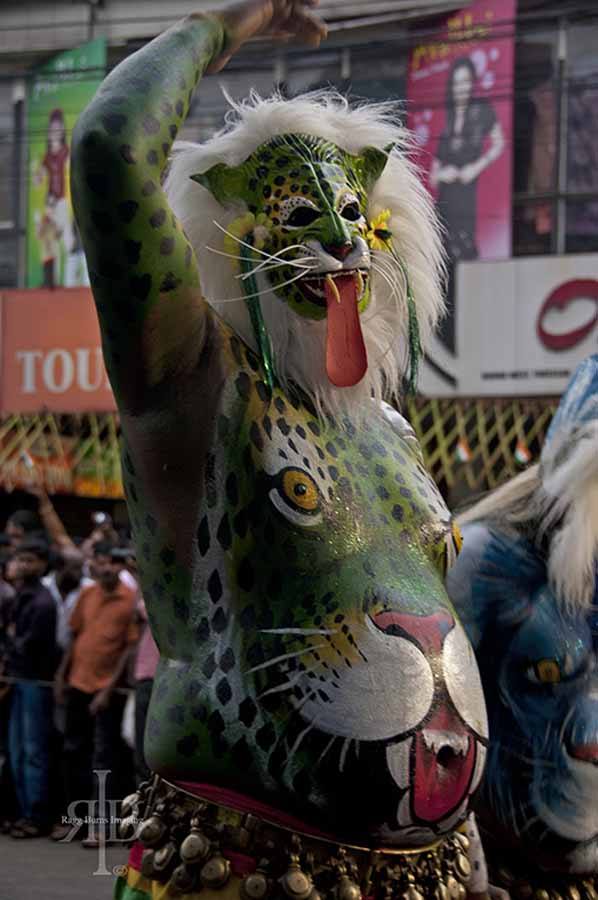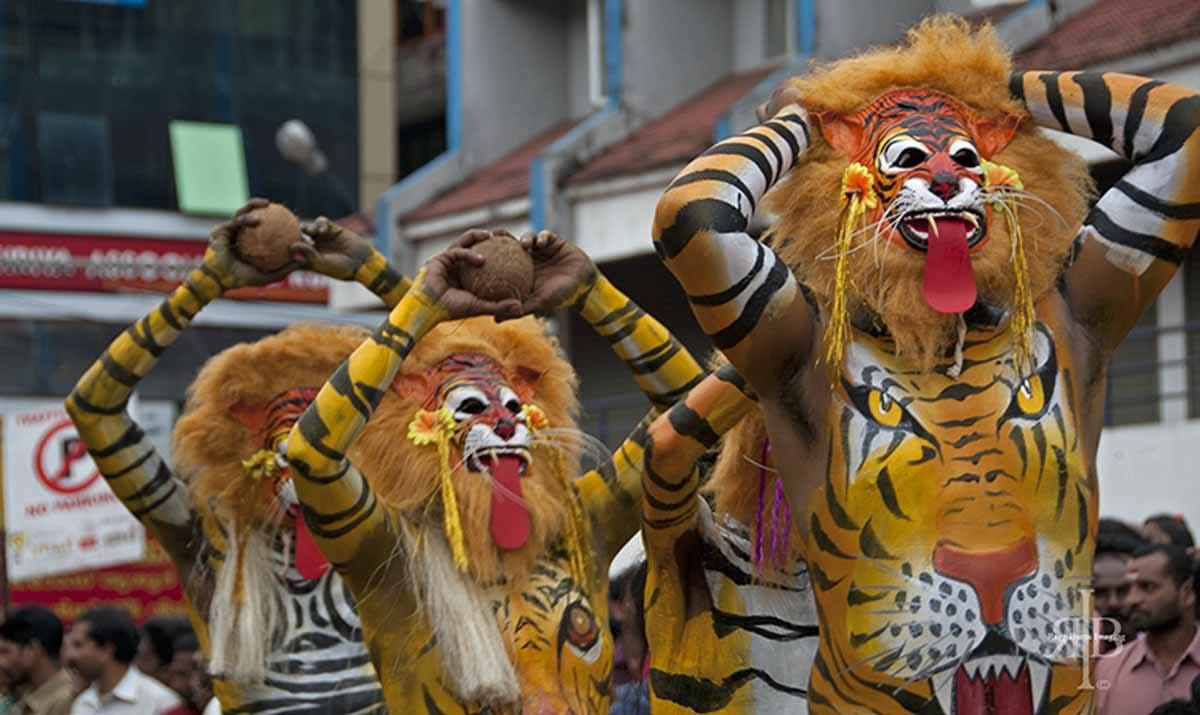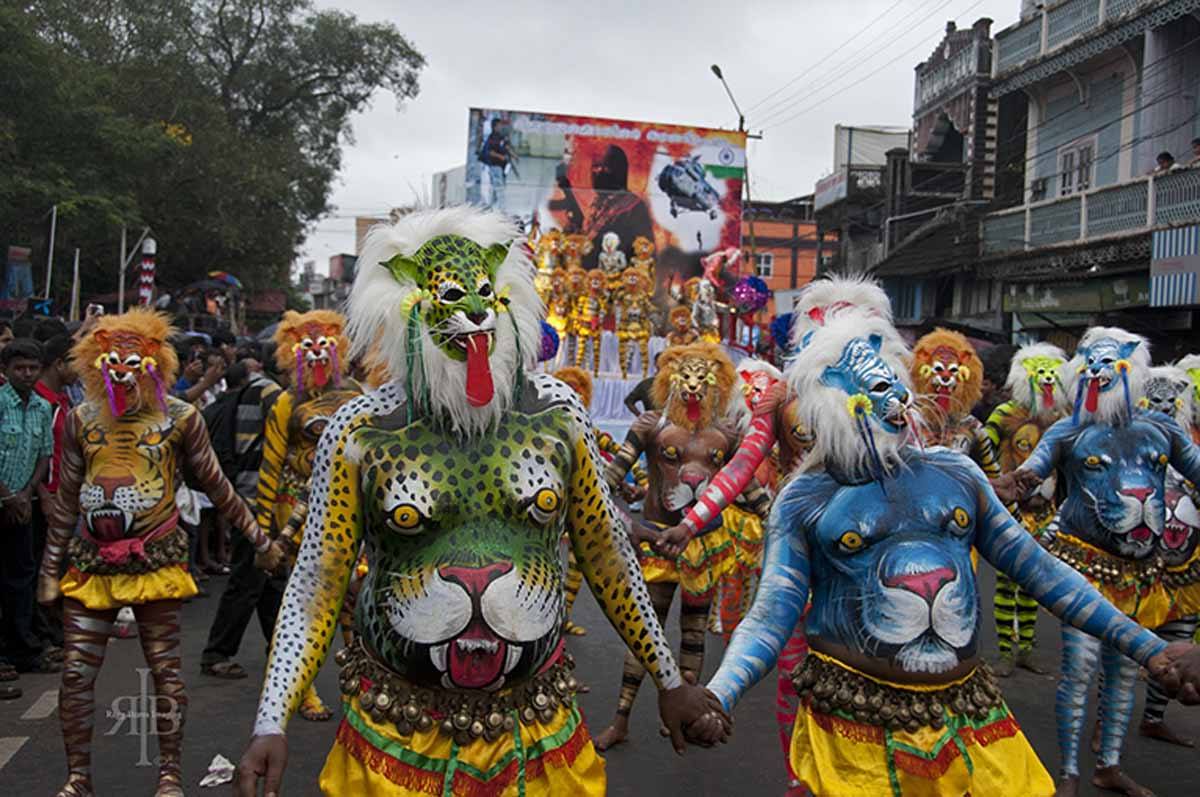Did you know that there is one day in the year when pot-bellied men are all the rage? And there’s more. Pot-bellied men, sporting tiger body-paint, dancing around the streets. No, I’m not making fun of you. It’s Pulikkali, our latest Festival Friday instalment.
Boys, before you reach for the pies, and the body paint, read on. Pulikkali is not a festival as such, it’s part of one. Pulikkali is a folk art, where dancers (usually middle aged, portly men) painted like tigers parade around the streets of Thrissur, a town in the state of Kerala.
Pulikkali is one of the celebrations taking place during Onam, the state’s most important festival. Last week’s Festival Friday post was also dedicated to Onam and the tragic life of temple elephants. Pulikkali was nothing of the sort. It is, or at least appeared to be, a day of total, exclusive, unadulterated fun.

Normally, whenever starting a festival piece, I start going on and on writing how amazing it was, mincing words on the deep and meaningful emotions stirred by witnessing traditions that date back millennia. Once again, Pulikkali was nothing of the sort. It was a day of fun, of joy in the streets.

And it doesn’t even date back to the dawn of times, having been created only two hundred years ago. Maharaja Rama Varma Sakthan Thampuran, maharaja of Cochin between 1790 ans 1805, is credited with having invented Pulikkali. He wanted to introduce a new type of performance, part dance part street art, to reflect the macho power of the army. Pulikkali was born. On the fourth day of Onam, groups of men take to the streets in tiger body paint, performing a dance that is reminiscent of tiger hunting.

Nowadays Pulikkali takes place every year in Thrissur, where Pulikkali troupes from all the state gather to show their skills. In the early days, performers wore paint all over, including their faces. Nowadays, they wear tiger masks, complete with fangs, whiskers and long rubbery tongues.
The body paint is just stunning, a concoction of tempera powder and varnish, thick and glossy, with wonderful colourful hues; not only yellow, orange and brown, but green, purple and pink as well. Artists are recruited especially to apply the tiger paint, a process that starts in the wee hours of the morning.

On the day, dozens of Pulikkali troupes gather at Swaraj Round, a large square in the heart of Thrissur. Parades start in the afternoon, and continue until sundown, accompanied by traditional instruments. It was great fun to follow the parade, and the atmosphere was nothing but joy and merriment.
Very few Western tourists were there; we counted no more than half a dozen. Thanks to our big DSLR cameras we were taken for members of the press, and given free access to all sections of the parade, allowing us to get some great shots.

We can’t recommend Pulikkali highly enough. Parading down the streets, dancing with the locals, watching wobbly bellies in tiger stripes bounce up and down, was just terrific fun. It was a battle of the bellies; the bigger, the wobblier, the better. Save for some young boys, probably the baby tigers, opening the parade with skips and cartwheels.

We thought Pulikkali was one of the biggest and most famous celebrations in Kerala, and its days would be all but numbered. Then we came across this Times of India article, mentioning that Pulikkali has been declining for years. It’s just becoming too expensive, apparently. The jolly pot-bellied men aren’t villagers, but professional performers, each of them with 15,000 rupees price tag for a two-hour dance. With an average number of 40 men for each troupe, prices do add up quickly.
After researching the matter of elephant parades, learning that Pulikkali’s days might be numbered because of money made me feel really sad. Every year, hundreds of elephants suffer incredible torture during festivals around the state, and an incredible amount of money changes hands. Yet, a festival that is just pure fun, and hurts nobody, is in danger of disappearing. I just wish it won’t happen.



Now, this looks like quite the colorful festival! For once, you wouldn’t have to be trying to hide your pot belly :-). Now if only there was a festival for pot-bellied women to parade in…
hahaha so true! maybe we should start a festival for pot-bellied ladies!
That looks completely brilliant, I love learning about different festivals! Love your pictures!
Hey Emma! It was great fun, thanks for your comment!
What an interesting and colorful parade! However, I guess it was disappointing to hear that everyone is just paid performers.
hey Jessica! You’re right, but it was amazing nonetheless, definitely recommend it if you’re in the area!
I love this. I would definitely go…love your photos!
Thanks Corinne! It was a great experience!
Fantastic! I absolutely LOVE all the photos!
Thanks Jeanette! Glad you liked the pics.
Pulikkali seems like a fun festival (how about those bellies!). So cool that you got mistaken for the press. Photos are really stunning! It pays sometimes to carry heavy cameras around :). Sad that the festival is in decline.
hey Frank! Glad to know you liked the pics. It was a crazy festival, really amazing though!
Wild! Such a cool festival and that’s incredible that your cameras secured you that type of access. I love the shot of the tigers joining hands, what a beautiful capture.
hey Dave! Glad you liked the festival shots, it was awesome fun. We were so lucky to be allowed in, definitely helped with the pics!
Oh my goodness, I wonder how long it must have taken them to paint themselves. Great pictures BTW.
Hey Bianca! Thanks for stopping by, glad you liked the pics!
Love the elaborate costumes, masks and paint! You got some amazing pictures, its always fun to be mistaken for press
Haha Simone, you’re right! When they went ‘this way madam, you’re journalist yes?’ I couldn’t believe my luck!
WOW now that is something I haven’t seen before! That is quite the spectacle – thanks for sharing!
Hey Alli! It was a great experience, would highly recommend it!
Haha I LOVE this! I so wish I could have seen it in person! Fantastic photo’s too, love the hand holding one! I wonder if they’ll let westerners join in if our belly’s are big enough? Pass me the pies!
Hey Mike! You’re so right… There would be plenty of westerners qualified to join!
I like the idea that a festival can be just for fun and not part of a deep meaningful experience!
Same here Karen, it was a welcome change from really sombre and solemn festivals!
How interesting!! And how sad that I know so little about my own country 🙁 I think I need to visit Thrissur during Pulikkali quickly before it declines into oblivion!
You should Surya, it’s great fun!
Cool pics, as always! This looks like such a cool parade – I love those tongues 🙂
Thanks Emily! Glad you love the pics, it was an amazing day out!
eugh minging bellies! But we love the paint work 😀 looks really cool
Hahaha Laura! The bellies are quite cool painted up, no?
This almost reminds me of the Carnaval in Brazil… how interesting. It’s a shame that cultural parades like these would disappear because of a lack of budget..
Hey Rashad! Thanks for your comment! It was an amazing festival, and it looked popular, so I was quite surprised to find out that it’s disappearing. How sad.
What a colorful festival! 🙂 I know a few people in my family who could take part in it 🙂 *giggles* Looks like a unique type of festival 🙂
Hey Samantha! You’re right, if we did a pot-bellied men festival here in Italy, there would be plenty of performers! Thanks for your comment!
How, in heck, did I not know about this? This is amazing! I’m racing right back up to the top of the page to take it all in a second time. What a fun and fabulous post 🙂
Hey Erin! Funnily enough, I saw an article on an inflight magazine, when we were airlifted out of Ladakh after the 2010 floods. I was heartbroken after witnessing so much destruction, and I got the feeling I should go to Kerala. It was amazing.
The best post I have seen for a long time. I lived in Kerala as a child and have been a bit reluctant to go back and visiting. You have just cured me for that! I am going to Kerala!
Hey Bente! Thanks for your comment, glad you liked the article. I’m really happy my post convinced you to go back to Kerala, I’m sure it would be great, and I’m looking forward to reading about it.
This is so cool. The bodypainting is awesome. Would love to see it in reality.
Hey Christina! Thanks for your comment, glad you liked it!
Wow, this looks like a LOT of fun. The care and time it must have taken to put together the elaborate paint jobs on all of the men. It’s incredible. Not one looks out of place. It’s sad to hear that it’s starting to die off though. Traditions like these need to be nurtured and kept up for the future.
Thanks Adelina. Glad you liked the post, it was a cool experience.
Ow boy, can’t believe how beautiful those tiger-body-paintings are! What a fun and original parade. I’ve never heard of it before, but it looks like a real fun and not-to-miss event! 🙂
It was indeed. Make sure you check it our if you’re ever in India!
What lovely, colorful photo’s! Looks like something you don’t want to miss out on. I’ve marked this one for later 🙂
Great choice! You should definitely go!
It looks so much fun and it is so colourful! I would take part for sure if I have the chance!
You should Elena, it’s great!
I have seen these Pulikali (Puliaattam) parades many many years back as a child, but never had an opportunity to do a photo journal. Glad you guys did it. The pictures are gorgeous! So much of intricate art has gone into creating the tiger face in all their bellies. Local festivals like these add a lot of value to overall travelling, isn’t it?
Thanks Anu! Glad you liked the pics. It was a great day out!
This looks like a really fun festival to be a part of. The intricate detail of the painted tiger faces is amazing. It’s a shame this festival is in the decline. It’s always sad to see traditions, no matter how new, start to dwindle. Beautiful photography as well!
Thanks Jules. It was an amazing day out, and it seemed so popular with locals, I was really surprised to find out that it was in danger of disappearing.
I’ve never heard of this and it looks incredible, i love your pictures. And also good to know if i continue eating like i do, i’ll have somewhere i can still dance when i’m older and ‘pot bellied’ 😉
Hay Brad! That’s exactly what my husband said… thanks for your comment!
Excellent! Those young tigers are cool too, dreaming I’m sure of the day that they too will be pot-bellied and portly. 🙂
Hahaha Bob, so right! I wonder if the festival will still exist though.
wow look at all those colorful bodies! It’s amazing, somehow in europe we never manage to reach the festival/parade level as they do in other countries 🙂
Hey Anto! Thanks for your comment, glad you liked the article! Pulikkali is definitely worth a trip, but even in Europe we have some great festivals… check my most recent article!
Oh Marissa, I really hope they’re wrong! It would be such a shame to lose such a great festival… so you should go, before it’s too late!
Been there, and enjoyed it. But I didn’t appreciate the treatment of temple elephants.